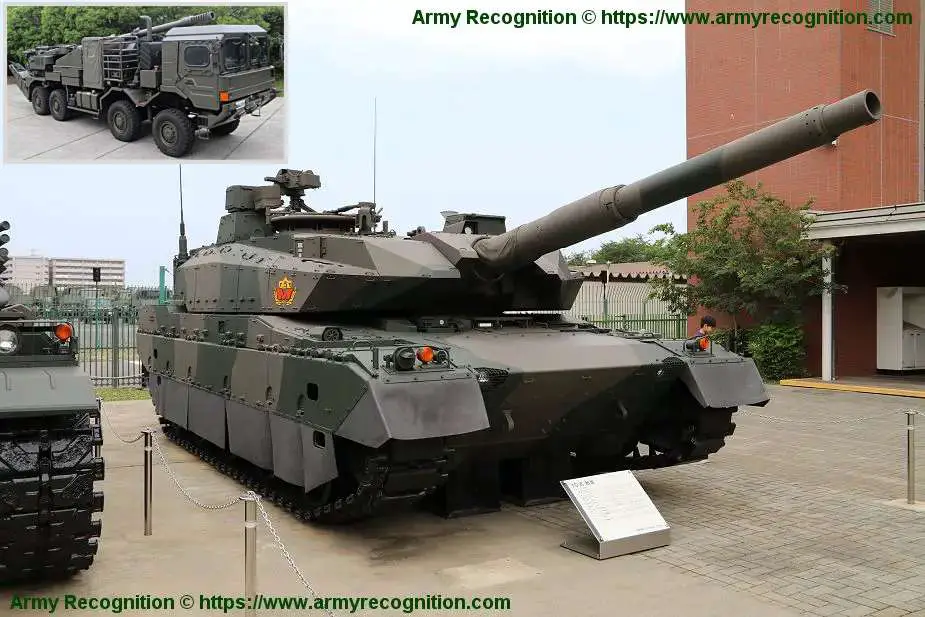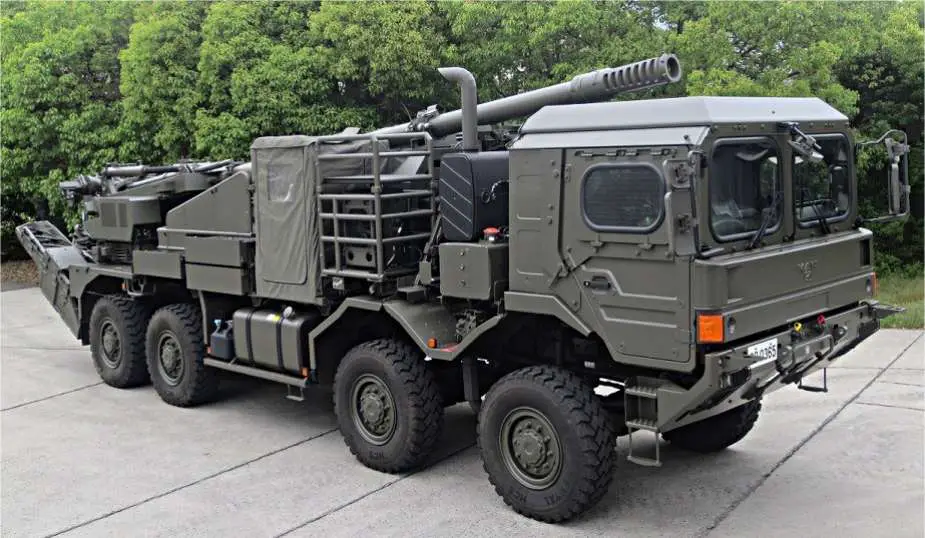Breaking news
Japan's 2024 defense budget secures 16 Type 19 howitzers and ten Type 10 tanks.
As of October 17, 2023, according to available information shared by Janes, the Japanese Ministry of Defense (MoD) has granted ¥16.8 billion (equivalent to $112 million) for the acquisition of ten Type 10 Main Battle Tanks and ¥15.1 billion (roughly $100.8 million) for the procurement of 16 Type 19 155mm self-propelled howitzers in its 2024 Defense budget.
Follow Army Recognition on Google News at this link

Japan's 2024 Defense budget secures 16 Type 19 Howitzers and ten Type 10 tanks (Picture source: Army Recognition and Japan MoD)
The Type 10 Main Battle Tank, recognized as a fourth-generation tank, is a product of Japanese military engineering. Developed by Mitsubishi Heavy Industries, this tank blends traditional design elements with advanced technology. With a wide range of features, the Type 10 MBT is considered among the world's modern main battle tanks.
The journey of the Type 10 began in 2002 when the Technical Research and Development Institute (TRDI) of Japan initiated Project TK-X. The goal was to create a fourth-generation main battle tank, with a focus on replacing the aging Type 74 tank, but also the more modern Type 90 tank. Despite its qualities, the Type 90 was considered too heavy by the Japanese army and was therefore limited in its movements by the infrastructure of the road network, although 65% of the main bridges in Japan were considered passable.
A prototype was assembled by 2006 and underwent rigorous testing. In 2009, the final design was approved, and production began in 2010. The first Type 10 MBTs entered service with the Japanese army in 2012. The Type 10 MBT follows a conventional main battle tank design, with the driver located at the front, the turret in the middle, and the power pack at the rear. The tank's crew consists of three members: the driver, the gunner, and the tank commander.
The Type 10's primary weapon is a 120mm, 44-caliber smooth-bore gun, which is licensed and built by Japan Steel Works and ATLA. This gun features advanced components like a thermal sleeve, a fume extractor, and a muzzle reference system. The 120mm gun is loaded automatically from the turret bustle and can fire various 120mm ammunition types, including the third-generation APFSDS-T (Armor Piercing Fin-Stabilized Discarding Sabot – Tracer) round.
One notable feature of the Type 10 MBT is its modular ceramic armor system designed to enhance protection against a variety of threats, including Rocket Propelled Grenades (RPGs), High-Explosive Anti-Tank (HEAT) projectiles, and anti-tank guided missiles. The modular armor system can be customized to address specific mission requirements. The tank's weight can vary, from 40 tons in its basic configuration to 48 tons when fully equipped.
The Type 10 MBT is powered by a water-cooled, four-stroke, eight-cylinder diesel engine producing 1200 horsepower at 2,300 RPM. This engine, developed by Mitsubishi, is paired with an MT1200 continuously variable transmission (CVT) gearbox. The Type 10 can reach a maximum speed of 70 km/h and, thanks to the CVT gearbox, can move equally fast in reverse, allowing for rapid changes in position. The tank has a maximum operational range of 500 km.
The Type 10 MBT incorporates advanced electronics, including a Battlefield Management System (BMS) that provides critical battlefield information to the tank commander. The system offers real-time data on friendly and enemy positions and maps, enhancing situational awareness. The tank also features a C4i System (Command, Control, Communications, Computers, and Intelligence) that interfaces with the BMS, enabling communication and information exchange with other military units, including infantry. Additionally, the C4i System is integrated with the Regiment Command Control System (ReCS), facilitating communication with nearby infantry units.
One of the key features of the Type 10 is its use of nanotechnology in its armor design. The tank's armor is composed of a fourth-generation composite material, constructed from ultra-hard nano-crystalline austenitic stainless steel. This approach, operating at the atomic level, results in denser and more resilient armor. The exact formulation of this armor is classified to protect its technological advantage. However, it is important to note that this advanced protection contributes to the Type 10's higher cost. Currently, around 99 to 106 Type 10 MBTs are in service.

The Type 19 self-propelled howitzer is armed with a 155mm/L52 gun, identical to the one mounted on the Type 99 tracked self-propelled howitzer (Picture source: Japan MoD)
In 2011, the Japanese Ministry of Defense recognized the need for a modern, mobile artillery system to replace the aging FH-70 towed howitzer. Inspired by existing self-propelled howitzers, this decision led to the development of the Type 19 155mm self-propelled howitzer.
The development project for the Type 19 commenced in 2013 under the guidance of Japan Steel Works. By 2018, five prototypes were assembled and underwent rigorous testing. In 2019, the Type 19 was officially unveiled in the East Fuji Maneuver Area and was rapidly accepted into service by the Japan Ground Self-Defense Forces (JGSDF), with the procurement of seven Type 19 howitzers initially allocated for training purposes, for a total value of 5.1 billion yen (roughly $34 million).
At the heart of the Type 19 is a 155mm/L52 gun, identical to the one mounted on the Type 99 tracked self-propelled howitzer. This gun, derived from the FH-70 howitzer, offers a maximum range of 30 km using standard High Explosive Fragmentation (HE-FRAG) shells. When utilizing rocket-assisted shells, the range extends to approximately 38 km. Furthermore, the howitzer can achieve a maximum firing rate of approximately 6 rounds per minute.
The Type 19 is operated by a crew of five, and the armored crew cab, located at the front of the vehicle, provides protection against small arms fire and artillery shell splinters for three of the crew members. The remaining two crew members are positioned in the middle of the truck chassis under a simple canvas cover, offering basic shelter but no additional protection.
The Type 19 is based on a German 8x8 HX 7 truck manufactured by Rheinmetall MAN Military Vehicles (RMMV). It is powered by a MAN DF2066 LF34 10.5-liter turbocharged diesel engine that delivers 440 horsepower. This engine, paired with a ZF 12-speed automatic transmission, allows a top road speed of 88 km/h and a range of approximately 800 km.
The Type 19 self-propelled howitzer is designed to excel in implementing the "shoot and scoot" tactic, enabling it to rapidly deploy, fire, and relocate, minimizing the risk of counter-battery fire. To maintain platform stability during firing, the Type 19 features a large spade that is hydraulically lowered at the rear. This spade absorbs firing stresses by raising the rear wheels off the ground.























